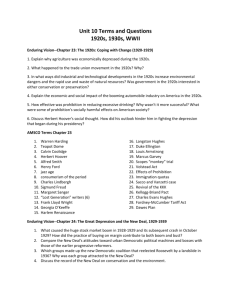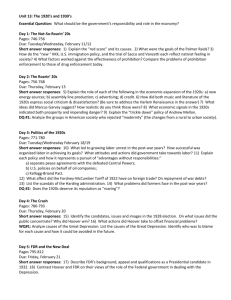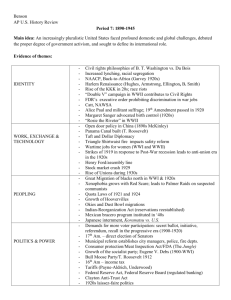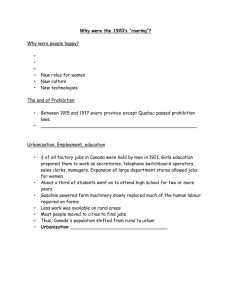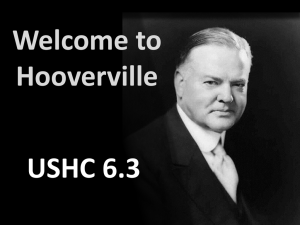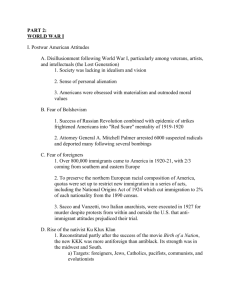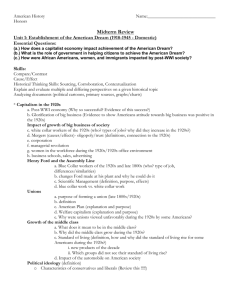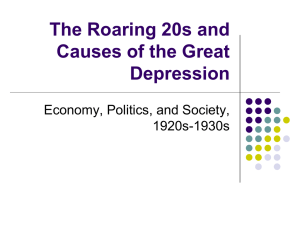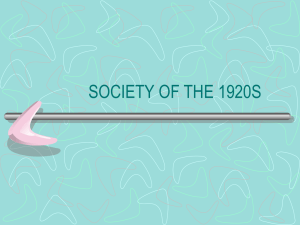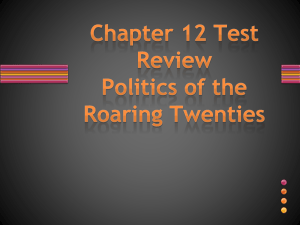US History 2R Chapter 20 Harlem Renaissance Lost generation
advertisement
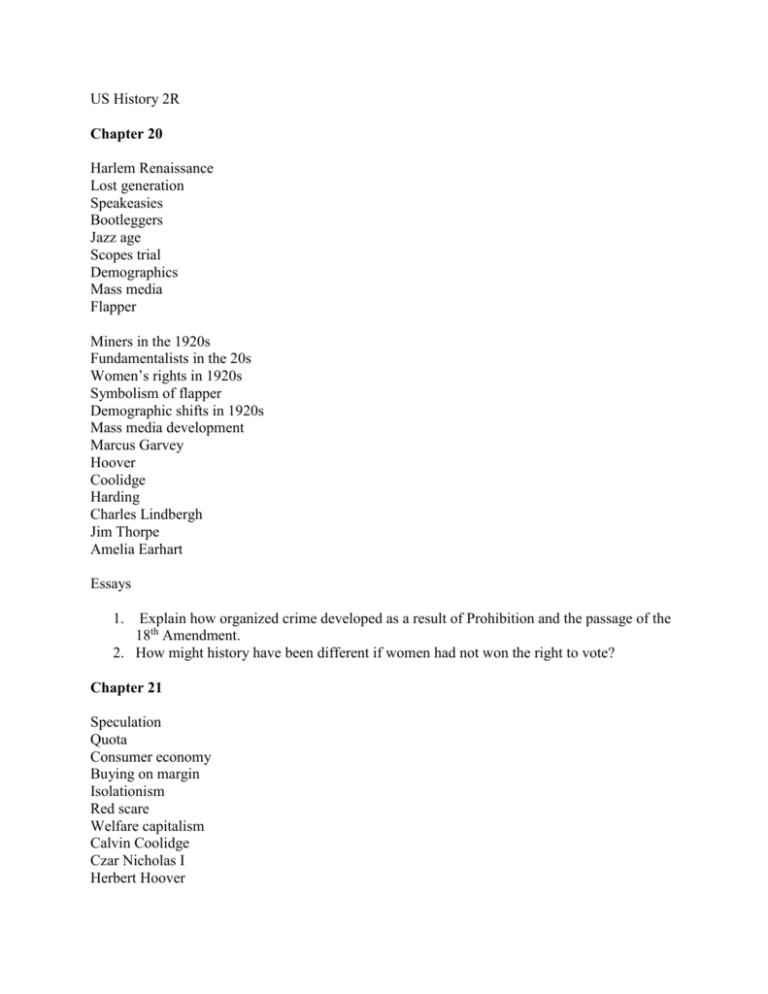
US History 2R Chapter 20 Harlem Renaissance Lost generation Speakeasies Bootleggers Jazz age Scopes trial Demographics Mass media Flapper Miners in the 1920s Fundamentalists in the 20s Women’s rights in 1920s Symbolism of flapper Demographic shifts in 1920s Mass media development Marcus Garvey Hoover Coolidge Harding Charles Lindbergh Jim Thorpe Amelia Earhart Essays 1. Explain how organized crime developed as a result of Prohibition and the passage of the 18th Amendment. 2. How might history have been different if women had not won the right to vote? Chapter 21 Speculation Quota Consumer economy Buying on margin Isolationism Red scare Welfare capitalism Calvin Coolidge Czar Nicholas I Herbert Hoover Alfred E. Smith Warren G. Harding John J. Rasko A. Mitchell Palmer Features of Republican Administrations in 1920s What was the red scare in response to? The growth of the economy during the 1920s Schenk v. United States/Oliver Wendell Holmes Hoover’s opponent in 1928 National Origins Act of 1924 Consumer economy Cause of rise in productivity during 20s Henry Ford’s business success Henry Ford’s dream Essays 1. Explain how the mass production of the automobile in the 1920s affected the economy of the United States. 2. Compare the governments of the United States and the Soviet Union in the 1920s Chapter 22 Herbert Hoover Bull market Bear market Speculation Black Tuesday Hoovervilles Bank panic Dow Jones Industrial Average Hawley Smoot Tariff Gross National Product (GNP) Causes of Great Depression Glass-Steagal Bank Act Reconstruction Finance Corporation Bonus army What did Veterans of Bonus Army want? Results of Stock Market Crash Unemployment during Great Depression Dust Bowl Essays 1. Give two reasons why many banks closed especially during the beginning of the Great Depression. 2. Explain why Americans lost their confidence in the U.S. economy during the Great Depression. Chapter 23 – The New Deal Key Terms, People, Places The New Deal Franklin D. Roosevelt Coalition Revenue Tennessee Valley Authority National debt Public works programs Demagogues Wagner Act Social Security System American Liberty League Who were the Progressives? FDR declared a “bank holiday” early in his administration. Why? The New Deal agency created to help businesses? Who made up FDR’s “brain trust?” Explain the Second New Deal What did the New Deal fail to address? List some criticisms from the Progressives of the New Deal Why are Huey Long and Fr. Charles E. Coughlin referred to as “demagogues?” What did people think of FDR’s attempt to “pack the Court?” List the legacies of the New Deal Essays 1. Why do you think some critics of the New Deal feared that its programs might lead to communism? 2. What beliefs do you think lay beneath the New Deal legislation that put women at a disadvantage in the work force? Chapter 24 Key Terms, People, Places Tojo Hideki Adolf Hitler Josef Stalin Charles de Gaulle Francisco Franco Blackshirts Winston Churchill Benito Mussolini Neville Chamberlain Jiang Jieshi Fascist Party Nazi Party Communists What did Italy, Germany and Japan have in common? What did America do in the early years of World War II? Who did we support? Why did the U.S. enter World War II? How did Josef Stalin dominate the Soviet Union? Mussolini and Hitler were both trying to expand their territory – for what reason? The Axis Powers – list the countries and explain the name “Axis” 1939 – a Fascist made a compact with a communist. Who were they? Who took over Manchuria in 1932? Where did the Burma Road lead? Where did the Japanese Navy believe they could beat the Americans? Essays 1. What factors motivated Italian, German and Japanese leaders to pursue aggressive foreign policies in the 1930s? 2. Do you think the United States would have entered WWII if the Japanese had not attacked Pearl Harbor? Use facts to explain. Chapter 25 Key Terms, People and Places GI War bonds Rations D-Day Carpet bombing Victory gardens U-boats Kamikaze Island hopping Liberty ships What was the purpose of the Office of Mobilizations? What prevented high spending in the U.S. during WWII? What is “deficit-spending?” Define code-talkers Define D-Day Be able to locate the Coral Sea, Midway and Guadalcanal on the map What ended WWII? Describe racial discrimination in the Northern U.S. during WWII What happened to Japanese-Americans living on the West Coast of the United States during WWII? Essays 1. The Supreme Court ruled in Korematsu v. United States that the wartime internment of Japanese Americans was justified because of the military urgency of the situation. What assumptions might have influenced the Court’s decision?
